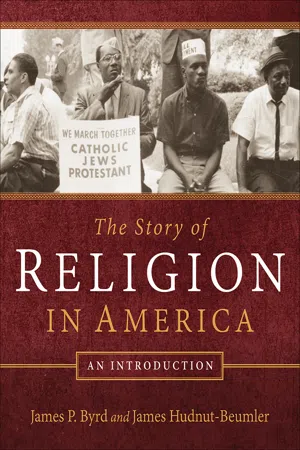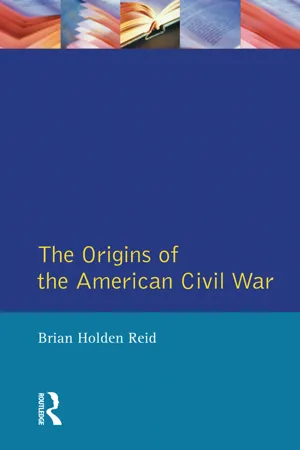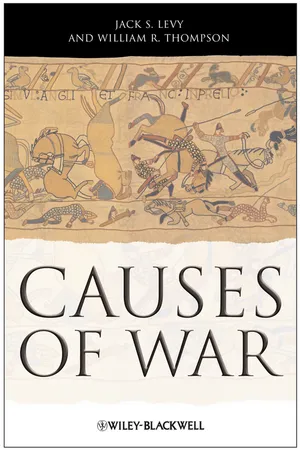Causes of the Civil War
The causes of the Civil War in the United States were rooted in long-standing tensions over issues such as slavery, states' rights, and economic differences between the North and South. The election of Abraham Lincoln in 1860, who opposed the expansion of slavery, further heightened these tensions, ultimately leading to the secession of Southern states and the outbreak of war in 1861.
5 Key excerpts on "Causes of the Civil War"
- eBook - ePub
Understanding Civil Wars
Continuity and change in intrastate conflict
- Edward Newman(Author)
- 2014(Publication Date)
- Routledge(Publisher)
...Above all, the debate about the causes of the conflict has been beset by differences in interpretation and historical revisionism. 5 This chapter will present the American Civil War as, in part, a violent process of statebuilding and consolidation. With a ‘long road’ to civil war, the causes and nature of the conflict will inevitably be elusive. 6 However, at least in terms of the narratives reflected in historical accounts, there is some consensus about the principal factors that form the background to the armed conflict. 7 For the political leaders of the southern states, who were generally economic pioneers embedded in agricultural production, a clear source of grievance can be seen. Southern elites perceived that the political agenda of the Unionist northern states, including the containment and eventual abolition of slavery, was an intolerable threat to their economic survival, which depended upon rural production and in particular cotton plantations. More broadly, the secession of Confederate states was driven by resistance to the consolidation of the country, as it was perceived, around northern interests and northern visions of modernity and progress. This consolidation exposed different economic, cultural, political and social realities in the north and south, and led to seemingly incompatible visions of the role of the nation-state. The agenda of the elites of the south was to secede from this northern-dominated model of development and statebuilding. The conflict was therefore not an attempt by the south to compel a way of political and economic life onto the Union, but to secede from it...
- eBook - ePub
The Story of Religion in America
An Introduction
- James P. Byrd, James Hudnut-Beumler(Authors)
- 2021(Publication Date)
- Westminster John Knox Press(Publisher)
...9. Slavery and the Civil War The Civil War (1861–65) was the most catastrophic war in American history: over 700,000 Americans died. Through all the devastation, Americans looked to God and the Bible for support and consolation. For both the Union and the Confederacy, it was a sacred war, and slavery was at the center of it. Although various issues surrounded the war, including states’ rights and loyalty to the Union, the main cause was the conflict over slavery. Nobody knew this better than Abraham Lincoln. In his Second Inaugural Address, delivered near the end of the war, he said it clearly: “Slaves constituted a peculiar and powerful interest. All knew that this interest was somehow the cause of the war.” 1 Most Americans agreed that slavery was inseparable from religion. Some called it God’s blessing, destined to enrich the South and to bring the gospel to “heathen” Africans; others called slavery the nation’s curse, a diabolical institution that offended God and made a mockery of the nation’s claim to be a land of liberty. Americans divided over slavery; they claimed God’s endorsement for their views, transforming them into sacred convictions worth fighting (and dying) for by the hundreds of thousands. American views of religion, violence, and the nation’s mission would never be the same. Slavery and the Nation’s Founding As we have seen, the American Revolution tragically failed to abolish slavery. A new nation that claimed to be based on the principles of human equality and natural rights supported the enslavement of human beings. Recognizing this glaring contradiction, several prominent founders claimed that slavery was on the road to extinction. For much of the founding era, slavery was the elephant in the room—constantly thought about, sometimes complained about, but ignored whenever possible. The Constitution said nothing about freeing enslaved people, and it protected the slave trade until 1808...
- eBook - ePub
Inquiry-Based Lessons in U.S. History
Decoding the Past (Grades 5-8)
- Jana Kirchner, Andrew McMichael(Authors)
- 2021(Publication Date)
- Routledge(Publisher)
...1850–1865 CHAPTER 8 SECTIONALISM AND CIVIL WAR DOI:10.4324/9781003235781-8 Both parties deprecated war, but one of them would make war rather than let the nation survive, and the other would accept war rather than let it perish. And the war came.—Abraham Lincoln, Second Inaugural Address, March 4, 1865 HISTORICAL BACKGROUND: WHAT DO I NEED TO KNOW? The opening of the West that brought so much opportunity to the United States also nearly proved its undoing. Although most Americans in 1787 assumed that slavery would soon die off, the invention of the cotton gin brought new profitability to slave plantations, and slave owners felt the same westward pull as other Americans. Some Americans, however, began to argue that where slavery was legal, true opportunity was restricted to a very small elite. Whatever their feelings about African Americans, some White Americans began to equate slavery with backwardness and decided that it should be kept out of the new territories. In 1819, Alabama entered the Union as a slave state, which balanced the number of free and slave states, and therefore, senators. Maine’s petition for statehood in 1820 threatened to throw off the balance. In the Compromise of 1820, Congress agreed to admit Maine as a free state, Missouri as a slave state, and prohibited slavery in the Western territories north of the southern Missouri border. The Compromise of 1850, an outgrowth of the results of the Mexican-American War, left the institution essentially intact, although it did bar the slave trade (but not slavery) in Washington, D.C., strengthened the Fugitive Slave Act, and admitted California as a free state. Far from pushing slavery into the background, the Compromise of 1850 brought slavery into the heart of American politics. Congress passed the Kansas-Nebraska Act in 1854, which opened the territory to settlement, but also gave White male inhabitants the right to vote for or against slavery. This repeal of the Missouri Compromise caused outrage...
- eBook - ePub
- Brian Holden Reid(Author)
- 2014(Publication Date)
- Routledge(Publisher)
...The break-up of the Union, a continental republic which dominated the region, would introduce a mechanism resembling the European balance of power between smaller, competing states. ‘But a balance of power’, Professor Connell-Smith argues, ‘was precisely what the United States would not permit in the Americas. She was determined to maintain an imbalance which was so markedly – and increasingly – in her interests’. Thus a major question that needs to be answered is why the American Civil War remained a local conflict? Why did it not spread into a wider conflagration, particularly given its length and intensity? Related to this issue was the manner in which the war developed into what the twentieth century calls a ‘total’ war. The destruction of the Confederacy, the abolition of slavery and the military occupation of the southern states until 1877 prevented any extension to North America of a balance of power. In 1895 President Grover Cleveland’s Secretary of State, Richard Olney, boasted that ‘Today the United States is practically sovereign on this continent and its fiat is law upon the subjects to which it confines its interposition’. This was possible, Olney explained, because the United States’ ‘infinite resources, combined with its isolated position render it master of the situation and practically invulnerable as against any or all other powers’. The firing at Fort Sumter presented an opportunity for preventing such an accretion of power and strategic invulnerability. The attitude of the United States to foreign powers was conditioned largely by progress on the military front. The danger that a European power might intervene was most urgent when Union armies were routed and Confederate forces invaded northern soil. The thorny problem of war aims is also related to the fate of northern and southern arms...
- eBook - ePub
- Jack S. Levy, William R. Thompson(Authors)
- 2011(Publication Date)
- Wiley-Blackwell(Publisher)
...Thus, a different presentation strategy for civil war causes seems necessary. We will keep levels of analysis in mind but not insist that the arguments about the causes of civil war fit within them neatly. To set the stage for discussing different interpretations of civil war causes, we need to introduce briefly the “old war/new war” debate, which we mentioned in chapter 1. Emblematic of this debate is Kaldor’s (1999) perspective. Kaldor maintains that the type of warfare that became most prevalent in the past three to four centuries was closely tied to the relatively recent emergence of the nation-state organizational format. The primary goals of interstate warfare moved from a focus on territorial delineations and aristocratic inheritance squabbles to national and ideological disputes. In conjunction with these shifting goals, states became predominant and increasingly inclined to operate as blocs. Their armies transited through corresponding shifts of emphasis on mercenaries, professionals, conscripts, and back to professionals, this time with high technological proficiencies. Reliance on firearms gave way gradually to industrialized technology and successively greater lethality. All of these changes were supported by the expansion of the state’s bureaucracy, increasingly effective means of mobilizing resources from the population and economy, and tighter connections between state, military, and industry. 8 Along the way and equally linked closely to the evolution of the modern state, a number of distinctions between what is public and private, internal and external, economic and political, civilian and military, and war and peace came into practice. Kaldor’s basic argument is that just as the wars with which we are most familiar were closely linked to the evolution of the modern state, the emergence of different types of political organization will lead to the supplanting of the old forms of warfare and associated conventions by new types of war and related norms...




